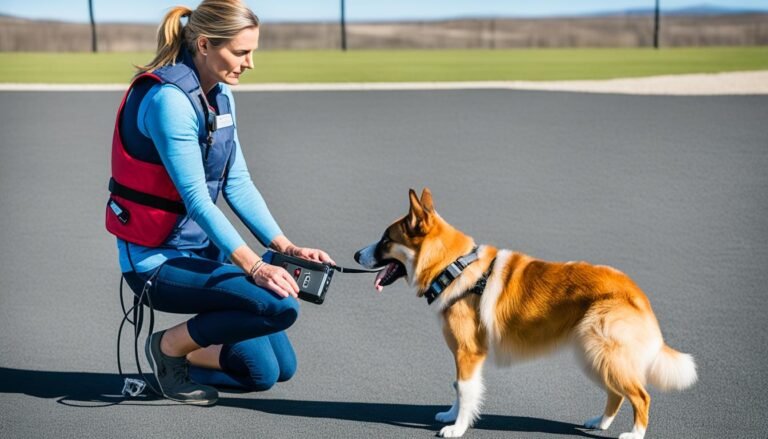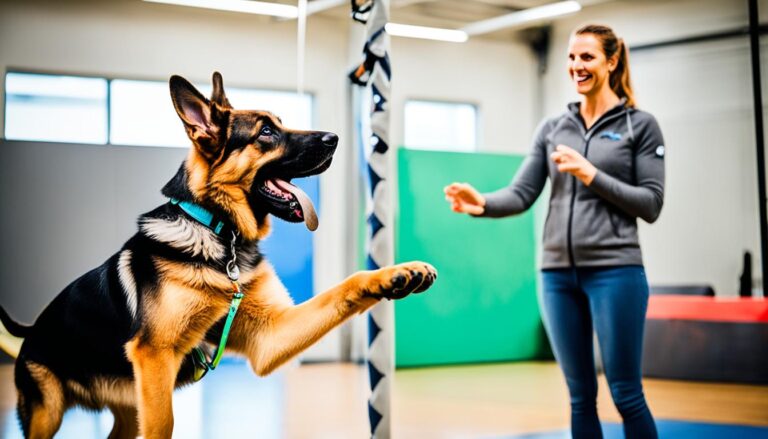How to Use a Dog Training Collar
Training your dog is essential for a positive relationship and a well-behaved pet. But sometimes, it can be challenging to teach them the behaviors you want. That’s where a dog training collar comes in. Using this tool can make the training process easier and more effective, helping you and your furry friend achieve your goals.
Imagine this: you have a lovable pup named Max who is as energetic as can be. While his enthusiasm is contagious, it can sometimes get him into trouble. Max loves to greet everyone he meets by jumping up and pawing at them. You’ve tried various training methods, but nothing seems to work.
That’s when a friend recommends using a dog training collar. Skeptical at first, you decide to give it a try. You do some research and come across a step-by-step guide for dog training collar usage that gives you confidence. With a bit of skepticism, you purchase the collar, hoping it will help tame Max’s exuberance.
The day comes when you finally put the collar on Max. With a few adjustments to ensure a proper fit, you’re ready to begin. The collar offers different options, including tone and stimulation, allowing you to choose the most effective method for Max’s training.
As you approach a neighbor during your daily walk, Max begins to jump up excitedly. Instead of shouting his name and pulling on the leash, you press a button on the dog training collar that emits a gentle vibration.
Max is taken aback by the sensation and quickly plops down onto the ground. You seize this opportunity to reward him with praise and a treat. In just a few repetitions, Max learns that jumping is not acceptable behavior.
You continue to use the dog training collar to teach him other basic commands like sit, stay, and come. With each successful training session, your bond with Max grows stronger, and you marvel at the effectiveness of the collar.
By mastering the use of a dog training collar and implementing proper techniques for dog collar training, you successfully integrate this tool into Max’s training routine. You both enjoy a positive experience, and Max becomes a model of good behavior.
In this article, you’ll learn how to properly fit a dog training collar, best practices for using a dog training collar, how to introduce your dog to this new tool, and effective ways to utilize it for teaching commands and correcting unwanted behaviors.
Get ready to enhance your dog’s behavior and strengthen your relationship through the power of a dog training collar. Let’s dive in!
The Importance of Using a Dog Training Collar
Using a dog training collar can bring a multitude of benefits to both you and your furry companion. It offers an effective solution for correcting unwanted behaviors, such as jumping, digging, chasing, and excessive barking. With the use of a dog training collar, you can also teach your dog essential commands like sit, come, stay, and heel, fostering obedience and safety.
One of the significant advantages of dog collar training is its ability to address specific behavioral issues. Whether your dog exhibits excessive barking or engages in destructive behaviors, a training collar can provide the necessary correction to redirect their actions. By utilizing this training tool, you can effectively communicate with your dog and instill positive behavior patterns.
Moreover, incorporating a dog training collar into your training routine strengthens the bond between you and your pet. The collar facilitates clear communication and consistent guidance, enabling you to establish trust and reinforce your role as the leader. Through this process, both you and your dog can develop a harmonious relationship built on respect and understanding.
No image was provided for this section.
Properly Fitting the Dog Training Collar
Before using a dog training collar, it’s crucial to ensure that it fits your dog properly. A correct fit is essential for both the effectiveness and the comfort of your pet. Follow these simple steps to ensure a proper fit:
- Make sure the collar is turned off.
- Fit the collar while your dog is standing comfortably.
- Check the fit by inserting one finger between the collar and your dog’s neck. The collar should be snug but not too tight.
- Let your dog wear the collar for a few minutes to get comfortable.
- Check the fit again to make sure it hasn’t become too tight or loose.
By following these steps, you can ensure that the dog training collar fits your pet properly, providing maximum effectiveness during training sessions while keeping your dog comfortable and safe.
Introducing the Dog to the Dog Training Collar
Before you begin training, it’s crucial to introduce your furry companion to the dog training collar. This initial step will help them become familiar and comfortable with the collar, ensuring a smooth training process.
Start by allowing your dog to wear the training collar for a few days without activating any features. This will give them an opportunity to get used to the sensation of wearing the collar and prevent them from associating it solely with corrections.
During this acclimation period, reward your dog with praise and treats whenever they wear the collar. This positive reinforcement will create a positive association between the collar and positive experiences.
Once your dog is comfortable wearing the collar, you can start introducing the tone and stimulation features. Begin by associating the tone with rewards and praise. For example, when your dog responds correctly to a command, use the tone feature and reward them immediately.
Take small steps to gradually expose your dog to the stimulation feature. Start with the lowest level and observe your dog’s reaction. If they respond positively, reward them as a reinforcement. Always support the introduction of the stimulation feature with positive reinforcement to ensure a positive association.
Remember, the key is to introduce the collar gradually and create positive experiences for your dog. Building trust and familiarity with the training collar will set a strong foundation for effective training sessions.
Now that you have successfully introduced your dog to the training collar, you can move on to teaching them basic commands. Continue reading to learn how to start basic commands with the dog training collar.
Starting Basic Commands with the Dog Training Collar
Now that your dog is comfortable with the training collar, it’s time to start teaching them some basic commands. Using an electric dog training collar can be an effective tool for this purpose. Let’s begin with the sit command.
The Sit Command
- Put a separate non-metallic collar on your dog’s neck.
- Hold the leash and the dog training collar.
- Guide your dog into the sitting position.
- Press and hold the stimulation button on the training collar.
- Give the command “sit”.
- Release the stimulation button when your dog is in the sitting position.
- Praise your dog for obeying the command.
- Repeat the process to reinforce the sit command.

The same steps can be applied to teach other basic commands using the dog training collar. For the come command, guide your dog towards you while pressing the stimulation button and give the command “come”. Release the button when your dog reaches you and praise them. For the stay command, guide your dog into a sitting or lying position, press the stimulation button, and give the command “stay”. Release the button after a few seconds and reward your dog if they stay in place. Lastly, for the heel command, walk your dog on a leash while pressing the stimulation button intermittently to encourage walking by your side. Give the command “heel” and praise your dog when they walk properly.
Remember to be patient and consistent in your training. Using a dog training collar can greatly assist in teaching your furry friend basic commands and improving their behavior.
Correcting Unwanted Behaviors with the Dog Training Collar
Along with teaching basic commands, a dog training collar is an effective tool for correcting unwanted behaviors. Whether it’s jumping, digging, or excessive barking, the dog training collar can help you address these behaviors and maintain a well-behaved pet.
Stopping Jumping with a Dog Training Collar
If your dog has a habit of jumping on people, the dog training collar can be used to prevent this behavior. When your dog attempts to jump, give the “sit” command firmly. At the same time, activate the dog training collar to discourage jumping. Release the stimulation when your dog responds to the command and sits down. Be sure to praise and reward your dog for appropriate behavior. Repeat this process consistently to reinforce the desired behavior and eliminate jumping.
Preventing Digging with a Dog Training Collar
Digging can be a frustrating behavior for many dog owners. To prevent your dog from digging, when you catch them in the act, activate the dog training collar. The stimulation will discourage the digging behavior. As soon as your dog stops digging, release the stimulation. By consistently applying this technique, your dog will learn that digging is an undesirable behavior, leading to a decrease in this unwanted habit.
Controlling Excessive Barking with a Dog Training Collar
Excessive barking can be a nuisance, both for you and your neighbors. The dog training collar can help you control and reduce excessive barking. When your dog starts barking excessively, use the dog training collar to interrupt this behavior. Activate the collar to deliver a stimulation that catches your dog’s attention and stops the barking. Release the stimulation when your dog has ceased barking for a few seconds. With consistent training, your dog will learn to associate excessive barking with an unpleasant sensation, ultimately leading to a decrease in barking episodes.
Overall, a dog training collar is a valuable tool for correcting unwanted behaviors in your dog. By addressing issues such as jumping, digging, and excessive barking, you can create a well-mannered and balanced pet. Remember to always use the dog training collar responsibly and follow proper training techniques to ensure the safety and well-being of your dog.

Reinforcing Learned Behaviors with the Dog Training Collar
Now that your dog has mastered the basic commands, it’s time to take their obedience to the next level. Using a dog training collar can be an effective tool for reinforcing learned behaviors and sharpening their obedience skills.
When your dog responds slowly or inconsistently to a command they already know, the dog training collar can be used to provide a correction. This correction helps to remind your dog of the expected behavior and encourages them to respond appropriately.
To reinforce a learned behavior with the dog training collar, follow these steps:
- Ensure that the collar is fitted correctly and comfortably on your dog.
- Give the command that your dog is familiar with.
- If your dog does not respond or responds incorrectly, use the dog training collar to deliver a corrective stimulation.
- As soon as your dog responds correctly, release the stimulation.
- Praise and reward your dog for their correct response.
- Repeat the process as needed to reinforce the behavior and improve your dog’s overall obedience.
Using the dog training collar as a reinforcement tool can be highly effective in sharpening your dog’s obedience. The timely corrections help your dog to better understand and comply with the commands they have already learned.
Remember to always use the dog training collar responsibly and with proper training techniques. Seek professional guidance if needed to ensure the safety and effectiveness of the training process.
Safety Considerations and Final Tips for Using a Dog Training Collar
When it comes to using a dog training collar, safety should always be your top priority. Follow these essential tips to ensure a positive and secure training experience for you and your furry companion.
1. Read and Follow the Manufacturer’s Instructions: Before using a dog training collar, carefully read the instructions provided by the manufacturer. Understand the features, settings, and proper usage guidelines to avoid any potential harm to your dog.
2. Start with the Lowest Level of Stimulation: Begin the training process with the lowest level of stimulation on the collar. This allows you to gauge your dog’s reaction and determine the appropriate intensity to achieve the desired results. Gradually increase the stimulation level only if necessary.
3. Never Use the Collar to Introduce New Commands or Punish Your Dog: A dog training collar should only be used to reinforce learned behaviors and not as a means to introduce new commands or punish your dog. Focus on positive reinforcement techniques that promote a trusting and respectful relationship with your pet.
4. Consider Seeking Professional Guidance: If you’re new to using a dog training collar or facing specific training challenges, it’s advisable to seek professional guidance from a certified dog trainer. They can provide expert advice, personalized techniques, and address any concerns you may have regarding the proper usage of the collar.
5. Ensure Proper Fit and Avoid Prolonged Use: Always ensure that the dog training collar fits properly on your dog’s neck. It should be snug, but not too tight, allowing for comfortable movement and breathing. Additionally, avoid leaving the collar on for more than 12 hours at a time to prevent discomfort or skin irritations.
By following these safety considerations and final tips for using a dog training collar, you can effectively enhance your dog’s training experience while prioritizing their well-being. Remember, a well-trained dog leads to a harmonious and fulfilling bond between you and your loyal companion.






